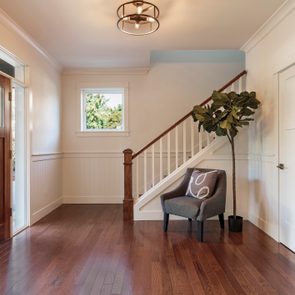10 Products That Help You Get Rid of Dust Mites
Updated: Oct. 10, 2022
Dust mites trigger allergy and asthma symptoms in many people. Here are the pillow and mattress covers, vacuum cleaners, detergents, and sprays that can help you kill dust mites.
Our editors and experts handpick every product we feature. We may earn a commission from your purchases.
Dust mite allergy symptoms
Dust mites surround us. They thrive in places we live, work, and play and are nearly impossible to avoid—unless you live in Antarctica.
These tiny creatures aren’t a concern for everyone. But for the millions of people with a sensitivity to environmental allergens, like dust mites, they can make life miserable.
“Dust mites are microscopic—people can’t see them—and people are not aware they are constantly being exposed to them,” says Belinda Graham, MD, an allergist with Wellstar Health System in Georgia.
According to the Asthma and Allergy Foundation of America, dust mites are considered the leading cause of year-round allergies and asthma.
Sneezing, coughing, runny noses, itchy eyes, and sore throats are common symptoms of an allergic reaction. Difficulty breathing, shortness of breath, and chest pain or tightness, are signs of asthma.
Medical professionals say the problem is many people have dust mite allergy symptoms and never consider tiny organisms are the cause.
What are dust mites?
Dust mites are not parasites that bite you and feed on your blood. But similar to bed bugs, they love warm environments, like your bedroom, so they snuggle deep inside your mattresses and pillows.
There are several varieties of mites, but it’s the house dust mite that invades your home, triggering allergies and asthma.
“North American house dust mites are small enough to fit through almost any crack, [so] they live in most houses,” says Frank Meek, technical services manager for Rollins, the parent company of Orkin pest control company.
According to the American Lung Association, about four out of every five houses has dust mites, creating a challenge for those with allergies or asthma.
The average life cycle of a dust mite is 65 to 100 days, and a mite goes from larva to adult in one month. Each female dust mite lays one to three eggs a day.
The problem is their source of food is always near. And that’s where humans come in.
“Since dust mites eat tiny flakes of skin on fabrics, getting rid of their food sources entirely is impossible,” explains Meek, a board-certified entomologist.
Most people shed about 1.5 grams of skin each day, which is enough to feed a million dust mites. Even without the human salad bar, dust mites can live off the waste and exoskeletons of dead mites.
“Therefore, in the typical household, an absence of food for dust mites just doesn’t exist,” Meek said.
The long reign of dust mites
The link between dust mites, allergies, and asthma dates back to the mid-1960s, but the history of mites began way earlier.
A study in PLOS Genetics found that dust mites evolved from a parasitic ancestor at least 48 million years ago. This was long before humans and after of the reign of dinosaurs. They share common ancestors with spiders and ticks.
From their first homes in prehistoric bird nests, dust mites moved into our homes, and are now among the most predominant species on earth.
Prevention and treatment for dust mites
Even the cleanest homes can be a haven for dust mites, says Meek. They’ve survived for eons by adapting and will likely survive for many more.
A 2017 study on dust mites in the World Allergy Organization Journal found that totally preventing dust mite exposure is practically impossible.
For those with allergies and asthma, “allergen reduction” methods in the home are key, says Dr. Graham, a board-certified allergist and immunologist. Here are the items to invest in for dust-mite prevention and treatment.
Coverings for mattresses and pillows
Dust mites love warm surroundings, so cover all mattresses and pillows in allergy-proof casings so dust mites can’t penetrate your bedding, advises Dr. Graham.
“It’s the single most important thing you can do to reduce your exposure to dust mites,” she advises.
When looking for a dust mite mattress cover or other coverings, look for a tight weave, not knitted or notched fabrics.
A 2018 study in The Journal of Allergy and Clinical Immunology: In Practice found that finely woven fabrics are best for coverings to keep dust mites out.
Make sure you also set a schedule, so you’re sure to change your sheets regularly.
Vacuum with a HEPA filter
There are likely more dust mites in your carpet than anywhere else in your home. One square yard of carpet can harbor up to 100,000 dust mites, according to the International Association of Certified Home Inspectors.
And dead dust mites can still trigger allergies.
Meek says to make sure your vacuum has a HEPA filter that can trap small particles, like dust mites and pollen.
These high-efficiency particle air filters can remove airborne particles as small as 0.3 microns. (Dust mites are 0.5 microns.)
Dehumidifier
Dust mites thrive in climates with humidity levels above 70 percent. They can’t drink water, so they absorb moisture from the air to survive. When humidity is low, they dry up and die.
According to the same 2017 study on dust mites in the World Allergy Organization Journal, humidity control was the key to managing dust mites.
Keeping your air conditioning at or below 68 degrees helps to keep humidity low, says Dr. Graham.
If you have allergies or asthma, a dehumidifier can help in rooms where you spend much of your time, like a bedroom or living room. It’s not a replacement for air conditioning, but it can make the process more efficient.
(Here are other ways doctors allergy-proof their homes.)
Dust cloths and cleaning spray
Dust mites aren’t just in dust, but a dusty area is an optimal environment for them to thrive and multiply.
“Regular cleaning is a very important part of an asthma and allergy healthier indoor air quality management plan,” says Sarajane Sparks Verghese, spokeswoman for the Asthma and Allergy Foundation of America.
Hypoallergenic detergents for laundry
Dr. Graham recommends her patients with allergies wash all sheets, comforters, and blankets at least once a week in hot water (at least 130 degrees) and completely dry the items on high heat.
Hot water and high heat will likely kill all dust mites, but she recommends detergents without dyes and chemicals, which can aggravate or trigger allergies and asthma.
(Also, opt for these hypoallergenic pillows.)
Pesticides that target dust mites
Dust mites are nearly impossible to “spray away.”
If there was a magic bullet to effectively kill dust mites in the home, we would have done it by now, says William Robinson, a former biology professor at Virginia Tech and author of nine books on pest management.
“[Humans] have been around for about 1.6 million years. Mites have been successful for about 90 million years, so they’ve got a head start,” he says.
Natural dust mite control
Robinson said he has been a skeptic of natural pest-control products, but has changed his mind over the years as more science and data back up using plant-based pesticides for home use.
Some promising research exists, pointing to essential oils, such as thyme and eucalyptus, and diffusers as ways to keep dust mites away from areas like bedrooms.
“There is good data for essential oils, so I don’t want to dismiss it,” says Robinson, who is chairman of the International Conference on Urban Pests. “There is not any specific data for dust mites yet, but I don’t think it should be discounted.”
Products to help kill and protect against dust mites
Here are specific product recommendations and treatments to opt for when managing the dust mites in your home.

Linenspa Mattress Encasement
If you’re going to try just one thing to keep dust mites at bay, opt for a dust mite mattress cover like this one from Linenspa. Just zip it over your mattress and it’ll provide a barrier against bed bugs, dust mites, and allergens.
The breathable fabric creates a cooler, more-comfortable sleep surface—no crinkling sound or plastic feel. It is also waterproof and machine washable, and it comes with a 10-year warranty.

Sure Guard Pillow Protectors
The next best item to protect against dust mites is a pillow protector, like this set of two from Sure Guard.
These are 100 percent waterproof and hypoallergenic, and they zip closed to completely seal off pillows from bed bugs, dust mites, mold, mildew, pollen, and pet dander. They’re also made from 100 percent cotton, so the cases are soft and quiet, maintaining the feel of your pillow.
(These are common indoor allergens.)

Hoover MaxLife Pro Pet Swivel Vacuum
The HEPA filter on the Hoover MaxLife Pro Pet Swivel vacuum captures and contains 99 percent of dust and allergens with an odor-minimizing filter to prevent them from reentering the air. It works on both hard floors and carpets.

Pro Breeze Dehumidifier
The highly rated Pro Breeze Dehumidifier is a lightweight, portable unit that can remove up to nine ounces of water a day in areas up to 215 square feet. It runs quietly and shuts off automatically when the water tank is full.

Guardsman Dusting Cloths
Guardsman Dusting Cloths help trap and lock in dust, unlike paper towels or other rags that just push around dust or leave fibers behind. The reusable cloths work on all hard surfaces and simply rinse and air dry for the next use.
It carries the Asthma and Allergy Friendly certification mark, which guides consumers on preferred products for allergy and asthma management.

Endust Multi-Surface Dusting Spray
Use the Guardsman cloths with Endust Multi-Surface Dusting Spray to pick up dust and remove allergens from anywhere in your house. The product is hypoallergenic, silicone free, and fragrance free, reducing allergens on surfaces and in the air.
It’s certified Asthma and Allergy Friendly, making it a smart choice for people with allergies and asthma.

EcosNext Liquidless Laundry Detergent
One top-rated laundry detergent for those with allergies and asthma is EcosNext Liquidless Laundry Detergent. It comes as a sheet, so there are no powders or measurements to deal with, and is made without dyes, brighteners, parabens, or phosphates.

Steri-Fab
Robinson recommends starting with the basics of vacuuming and mattress covers to control mites. If more treatment is needed, he says Steri-Fab is a popular pesticide choice. It is primarily alcohol based, he notes, which he is less likely to be misused or misapplied.
Steri-Fab is an EPA-registered virucidal agent, disinfectant, and insecticide in one product. It can be used directly on mattresses and upholstered furniture to target dust mites.

Natural Armor All-Natural Insect and Pest Killer
Natural Armor All-Natural Bug, Insect, and Pest Killer is a peppermint, clove, and vinegar formulation that can repel mites for up to 12 months.
Use it inside anywhere there is a dust mite issue, including furniture. It’s safe for people, pets, and the environment.

Eco-Defense Bed Bug Killer
Eco Defense Bed Bug Killer spray is another highly rated natural, nontoxic pesticide for dust mites. The active ingredients are derived from coconuts and geraniums and can be applied directly to sheets and mattresses.
Now that you know about these dust mite products, check out these other things allergists wish you knew.




















